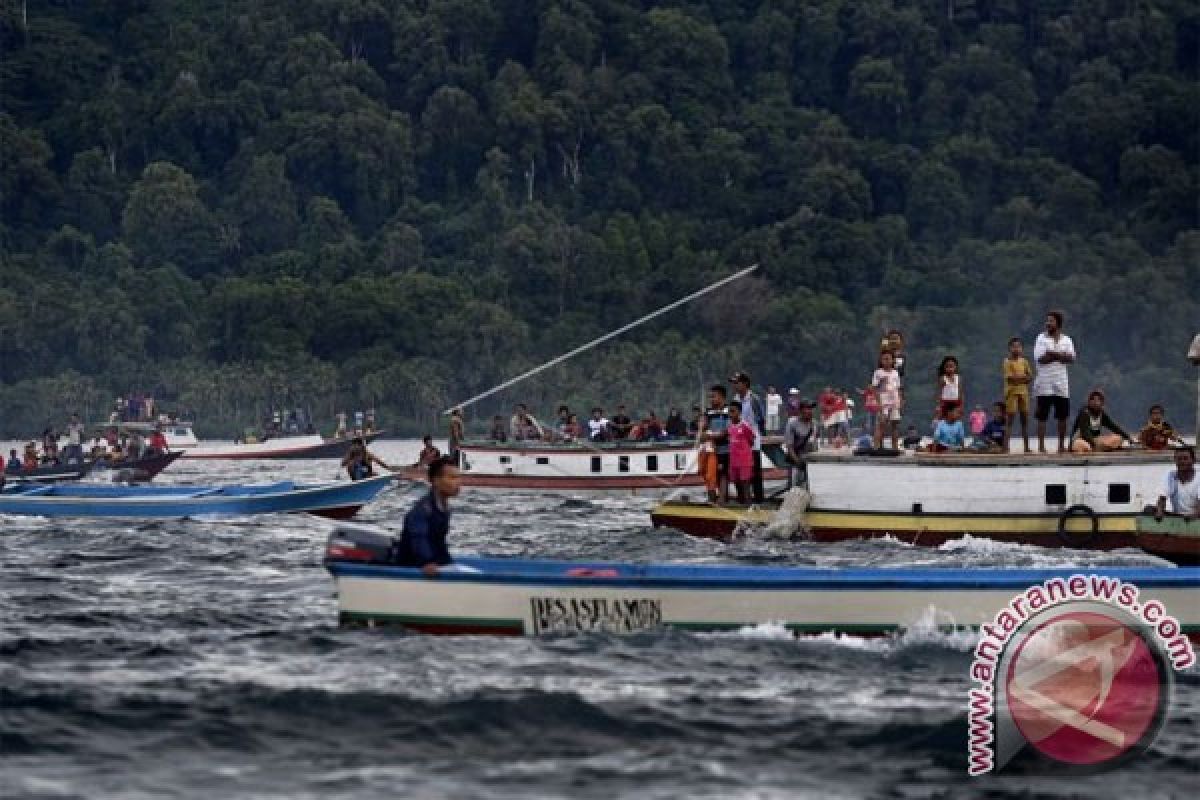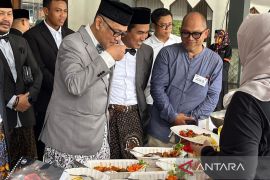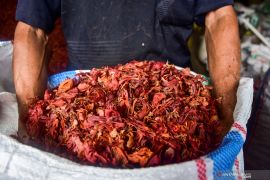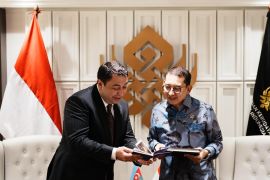The bride and groom wore magnificent crowns adorned with pearls. Massive parades were held in Bruges, tapestries were hung in homes, lavish feasts were held, festive masks were worn and jewels to impress every eye, which led to the event being dubbed as "the wedding of the century".
The dishes the Duke of Burgundy served at his wedding used a whopping 380 pounds of pepper. From this, one can conclude that pepper consumption per capita was 10 to 100 times greater at the time than today.
This historical snippet indicates the extraordinary behavior of European spice consumers in the Middle Ages, according to Prof. Erwiza Erman, research professor of local and global history at the Indonesian Institute of Sciences (LIPI).
At the time, spices were very expensive as they had to be transported over huge distances before they reached markets, that is, if they did not sink with the ship during a storm in the Indian Ocean, were lost to robbers, or cornered by pirates on the Silk Road.
From the 14th to 17th centuries, the Archipelago enjoyed a thriving pepper trade, even though the spice actually came from southern India, which it was native to, and was long ago brought and planted in what is today Indonesia.
Pepper flourished along the west coast of Sumatra, from Aceh to Lampung. The commodity was also grown in the south of Borneo, precisely in the south of Banjarmasin.
"We do not know when it was brought. Archaeological research needs to be carried out to find when it was traded. Pepper was palace food, so that in Europe there were marriages that cost 380 pounds of pepper and this indicates that this commodity was a prima donna," Erman said.
However, pepper is just one of the spices grown in tropical and subtropical regions. There are at least 500 to 700 species of spices grown worldwide, and the figure is likely to be higher, she added.
Addictive power of spices
Nutmeg (Myristica fragrans) and cloves (Syzygium aromaticum), which are native to the Maluku Islands, are two spices that have had a big influence on world history.
Clove traveled from the Archipelago all the way to Madagascar and Zanzibar in Africa, where it even underwent a shift in quality. African clove was exported to Indonesia in 1970-1980. In the meantime, Arab and Indian traders worked together to gain control of the clove trade, and their hold has lasted until today.
Meanwhile, nutmeg, which grows on the Banda Islands, Maluku, reached as far as Grenada in the Caribbean, considering that this area was once colonized by Portugal and Spain. But, what is clear is that since the 7th century AD, nutmeg has been widely used as a medicine in Syria and Arabia.
Nutmeg was also the second most important spice after pepper in Germany. According to Otto Warburg, winner of the Nobel Prize in Physiology or Medicine in 1931, writer Hildegard of Bingen, who lived there between 1098 and 1179, was the first to mention that eating nutmeg would open the heart and purify the senses and provide good understanding.
An exotic spice from the Banda Islands consumed in the same amount as cinnamon and cloves in a tart would soothe any bitterness of the heart, and make spirits cheerful, according to Bingen.
Meanwhile, a botanist from Nord-Pas de Calais, France, Mattaeus Lobelius in 1576 wrote a report about a "lethal dose" of nutmeg, which apparently showed its narcotic effect in producing bursts of laughter and hallucinations. Psychoactive substances make up about 15 percent of nutmeg oil, especially myristicin and elemicin, both of which are converted by liver enzymes into amphetamines, which are almost as effective as mescaline.
It was not surprising to see some people argue that spices had actually become addictive and made Europeans willing to take the trouble to look for new routes, circumventing the power of the Ottoman dynasty in Anatolia to reach the source of the opium.
The Portuguese explorer Bartholomew Dias undertook long voyages in 1487 along the west until he reached South Africa. He was followed by another Portuguese explorer Vasco da Gama in 1497-1498, who traveled all the way to Calicut, India, on the scent of the spice trail.
New trade routes
In the 10th to 15th centuries AD, the center of the spice trade was under a decentralized Islamic empire. Arab, Venetian, Genoese, and Pisan traders controlled the Mediterranean in 1450, and their ranks even included multimillionaires such as Filippo of Amedeo de Peruzzi and Jakob Fugger of Europe.
The control of Egypt and Turkey, which was under the Ottoman dynasty, was so strong on the spice trade at that time that it was incorporated in the North African region.
Meanwhile, the Kilwa Sultanate in Tanzania, led by a Persian prince named Ali ibn al-Hassan Shirazi, emerged as the largest maritime kingdom in East Africa, controlling trade routes to India, Sri Lanka, China, and even Australia for commodities ranging from spices, gold, elephant ivory, gems, and ceramics.
The Vasco da Gama fleet conquered the East African coast by following the Cape of Good Hope and started an era of Portuguese colonialism in Asia. Not satisfied with just controlling India by sending Dom Francisco de Almeida in 1509, the King of Portugal, Manuel I, sent his fleet, led by Diogo Lopes de Sequeira, to establish direct relations with Malacca, which became a strategic location controlling the spice trade between India and China.
Ferdinand Magellan, who later circumnavigated the globe with his sailing fleet, was also on board the ship to Malacca. However, Sequeira never succeeded in gaining control of Malacca.
It was only in 1511 that Afonso de Albuquerque, who had previously managed to conquer Goa, succeeded in taking control of Malacca and sent his envoys to establish maritime trade relations with China, Thailand, Timor, who finally managed to find the "Spice Islands" in Banda.
The special expedition to reach the Banda Islands, where nutmeg and cloves were located, was led by the Portuguese navigator Antonio de Abreu and explorer Francisco Serrao. They followed the east coast of Sumatra and the north coast of Java to reach Timor. The Portuguese were finally able to reach the Banda Islands in 1512.
The competition among the nations in Europe for control of the spice trade by sea was getting stronger and thereafter, led to the cutting off of the routes used by the Arab, Indian, and Chinese traders.
According to Erwina, in 1592, British troops once captured a Portuguese spice ship from the Azores containing 425 tons of pepper, 45 tons of cloves, 35 barrels of cinnamon, three tons of mace, three tons of nutmeg, 25 tons of cochineal, ebony, ivory, pearls, and gems. Its estimated value was nearly half a million pounds, she said.
The Portuguese controlled the spice trade by cooperating directly with the rulers in the Archipelago, competing with the Dutch, who eventually controlled it entirely through the trading company, Vereenigde Oostindische Compagnie (VOC) (1500-1800 AD).
The VOC, which was founded in March, 1602, received special privileges from the state or octrooi, which allowed it to raise an army, introduce its own currency, seize and occupy foreign areas outside the Netherlands, levy taxes, and negotiate with other countries to declare war, said Dr. Bondan Kanumoyoso, a historian from the University of Indonesia (UI).
They immediately set up their headquarters in Batavia on the island of Java, then the Banda Islands, where they exercised a monopoly on nutmeg and mace.
Corruption in the end "dissolved" the VOC. According to Kanumoyoso, the largest multinational trading company eventually went bankrupt because of its own employees and the invasion of the Netherlands by Napoleon Bonaparte's army in March, 1789, which led to it accruing huge debts.
In the 19th to 20th centuries, the spice routes from the Spice Islands began to fade, not as strongly as when the Roman Empire or the Ottoman dynasty controlled them, with the emergence of new prima donna commodities such as tea, coffee, sugar, and rubber, Erwina pointed out.
The aroma of the spices in the colonies created by the connected spice paths began to fade, leaving old stories about the greatness and addictiveness of pepper, nutmeg, cloves, cardamom, camphor, cumin, and other spices that enticed people for thousands of years. (INE)
Related news: Indonesian farmers should boost spice production akin to past: Jokowi
Related news: On the scent of the Dutch nutmeg on Banda Islands
EDITED BY INE
Editor: Fardah Assegaf
Copyright © ANTARA 2021












